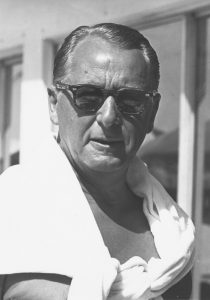
Below is what I know from growing up with him, from family stories, and from bits and pieces I’ve gleaned from a scrapbook he maintained in the late 1950’s and early 1960’s, and from his obituary. If you have corrections or additions of any kind, I’d love to hear from you at fcpinfo@francis-peters.com — thanks!
Life, Family, and Work
Francis Charles Peters was born in Dunkirk, NY on December 16, 1902 to Francis August and Agatha (Schmidt) Peters. He grew up in Buffalo where he attended the Albright Art School in 1919-20. He lived with his father after the passing of his mother and sister from tuberculosis when he was in his young teens. His daughter believes the family lived in the southwest (Texas, she thinks) for some time before their deaths, in hopes of a cure in that climate.
Francis wanted to attend university and was accepted at a school in Buffalo, but his father, not wanting to be alone, persuaded him to forego that education, although he did attend the Art Students League in New York City in 1924-25.
He worked in advertising for a number of years: he was Assistant Art Director at Lennon, Mitchel & Co in New York City in 1925-26; Director of Advertising for the Buffalo Athletic Club from 1926-28; and Assistant Director of Advertising at William A. Rogers, Ltd., from 1928-31. From 1932-40 he was partner at N. G. Bellinger & Co. who were involved with investment securities. From 1940-42 he was president of the American Durotex Co. in Buffalo.
During these years in Buffalo he met his wife, Bertha Doern, with whom he had a son in 1924 and a daughter in 1932.
With the onset of American involvement in the Second World War, the family moved to Falls Church (and a couple years later, McLean), Virginia and Francis worked as Deputy Director of the Industry Advisory Committee of the War Production Board in Washington, DC from 1942-1944 and as Assistant Administrator of the War Assets Administration from 1944-46.
In 1947 he joined his son in creating the Peters & Co. Real Estate agency, where he continued until leaving with his son-in-law to start a new real estate agency in the mid-1960’s. He worked actively until his death on August 12, 1977.
Painting
According to his daughter, who was 12 years old at the time, he started painting in late 1944 to entertain himself while sick in bed for a few days; he “borrowed” a set of oil paints and canvas boards she had recently received as a Christmas present and painted two small scenes of the views out his windows in McLean, VA. These original two paintings — as well as a copy of each that he made at an unknown date (perhaps near the same time since they appear to be on the same type of board) — still exist and can be found in the Town & Country gallery.
His paintings span three decades, with his last attempts in 1974 after suffering some vision impairment due to a stroke a year or two earlier. He was most active in the late 1950’s and throughout the 1960’s, both in terms of his output and his activities with art organizations, exhibitions, and shows.
An important influence on his painting style was the Canadian Group of Seven, with whom he became familiar after meeting Paul Rodrik, the son of Franz Johnston of that group. Paul and Francis met in Ontario in the summer of 1954 and/or 1955, and they formed a close and lasting friendship that included a number of painting trips in the later 1950’s and 1960’s. The influence of Rodrik and the Group of Seven on Francis’s style is readily discernible when comparing the paintings from 1945-55 with those from 1955-75: his depictions became much freer, bolder, and more expressive where before they tended to be more carefully and realistically rendered.
Despite this Canadian influence, Francis considered himself an American painter and had strong convictions about the importance of an American perspective in landscape painting, as he elaborated in some politically-tinged editorial letters you can find in his scrapbook.
Exhibitions
- Washington Art Club, 1952 – 1958
- Metropolitan Exhibition, 1954 – 1957
- Corcoran Gallery of Art, 1956
- American Artists Professional League, 1956 – 1958
Gallery Shows
- Rehobeth Gallery, 1960
- Washington Art Club, 1959
- Washington Landscape Club, 1964
- American Art League, Bachrach Award, Best in Show, 1967
- Arts Club of Washington, 1969
- Washington Gallery of Art, 1970
- Arts Club of Washington, Sep 8-27, 1974
Awards and Prizes
- American Artists Professional League, 1955, 1956
- Star Award, Washington Metropolitan Art Exhibition, 1956
- Washington Landscape Club, bronze medal, 1957
- Washington Art Club, 1957
- New Jersey State Award, 1959
Memberships and Affiliations
- Art Students League of New York
- National Advisory Board, American Artists Professional League, 1955-58
- American Art League, Founder, 1958; President 1966 – 1971
- Citizens’ Commission for the Preservation of HIstoric Buildings (Washington, DC)
- Washington Landscape Club, President 1964